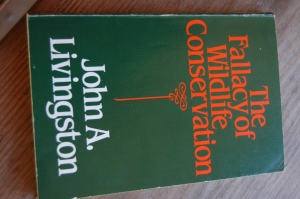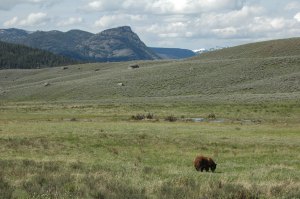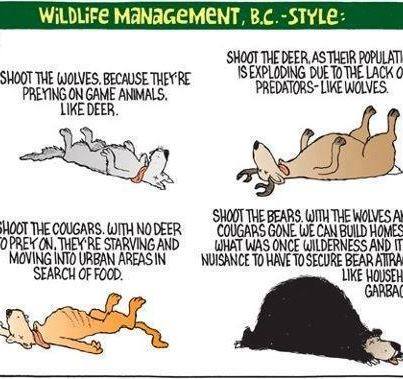The following is from Preface of the late Canadian naturalist, author and part-time misanthropist, John A. Livingston’s, book, Rouge Primate: “Having spent the greater part of a lifetime absorbed in the appreciation and the attempted understanding of living phenomena that are not human, while at the same time ceaselessly advocating their protection, preservation and ‘conservation,’ it was not easy to pause and evaluate the effectiveness—and logic—of that advocacy…But for my own peace of mind it needed doing. So in 1977 I did a critical analysis and wrote it up, then looked at what I had wrought for almost four years before publishing it. It was going to cost me, and it did.
“At the time of its publication, the American environmental teacher and essayist Joseph Meeker observed that my Fallacy of Wildlife Conservation appeared to be a book written in blood. It was indeed painful to have to acknowledge that the fundamental premises of the conventional conservation argument to which I had long adhered were radically flawed. It was even more painful to discover that rather than alleviating the parlous circumstances of the nonhuman world, the conventional conservation argument actually makes those circumstances worse. In that book I characterized customary wildlife conservation advocacy as a ‘catechism’ that I for one had been uncritically mouthing for too long.
“In a nutshell, the fallacy is the generally unchallenged belief that wild, undomesticated plants and animals and their communities can be enabled to survive the human presence on Earth by means of their careful safekeeping within the rational, managerial framework of ‘resource conservation.’ The belief is fallacious because to see any phenomenon as a ‘resource’ is to see it as a human utility or amenity. Such perception precludes the possibility of a non-quantifiable worth residing in that phenomenon—even to itself. Its value becomes purely instrumental. If such value cannot be shown, and in practice even if it can, the nonhuman is permitted to continue to exist solely at the human pleasure. Since resource conservation does not allow worth (to itself) to inhere in Nature, it can protect Nature only as the human estate, in which case it is no longer ‘Nature’ but rather an extension of the human apparatus. However argued or presented, resource conservation is a wholly proprietary, human-chauvinist concept.
“Here I mean resource conservation not as practice or policy, but as an idea. As such it requires the prior perception of the nonhuman world, and our relationship with it, in a very particular way. For any living being to be able to see other living beings as commodities or utilities would strike any naturalist as anomalous, even bizarre. Could it be possible for any nonhuman entity to see the world as its exclusive property, its vested estate, its heritage, its right and privilege, its fief? Surely not. But, the human animal does just that. Something is askew here.”
Meanwhile, from Livingston’s book Fallacy of Wildlife Conservation:
“Entirely out of control, the techno machine guzzles and lurches and vomits and rips its random crazy course over the once-blue planet, as though some filthy barbaric fist drunkenly swiping with a gigantic paint roller across an ancient tapestry.
“Unevenness in the rich textured nap of Earth’s surface causes the paint to cling slightly unevenly, with scattered spots and holes showing in the roller’s wake. These are the success stories. Isolated and discreet as they are, it’s quite possible that they can never recombine into a coherent whole.
“We are left with a miscellaneous rag-tag assortment of odd and disconnected relics—some larger, some smaller. In general, these gaps or anomalies tend to be in ‘frontier’ regions (arctic, rainforest), or in the great biological near-desert that is the open ocean. But the mindless machine has long since outgrown all restraint; the paint roller’s anti-biotic lacquer is thick, and fluid. If you watch, you can see its viscous pools widen as though of their own volition, toward the farthest reaches of life’s lovely tapestry.
“Wildlife communities are richer, in numbers of species, in equatorial regions than in higher latitudes. The greatest number of endangered species in the world today live in the tropics and sub-tropics. In underprivileged overpopulated countries I see no glimmer of hope for wildlife. It is simply too much to expect, for an entire catalog of reasons, that the care and maintenance of wildlife could possibly rise on the list of priorities (including accelerated industrial expansion) that exists in the tropics today. We should remember that there is little or no preservation tradition in most such places, in any event, and to think that such tradition could spring forth fully developed in the face of current events would be to abdicate common sense altogether. The human orgy has exactly one conceivable outcome for those species that are (a) edible, or (b) compete with man for food, or(c) compete with man for space. Perhaps this will change one day, but not soon. In the meantime, losses will have been colossal and extinctions will have been many. Extinctions without replacement—ever.
 “On the other hand, there are place in the world that are not yet populated toward the point of ignition. There are some spots not yet painted over, not yet obliterated. In spite of their technical grotesqueness, some of the hypermanaged western nations still have options having to do with open space, natural areas, living nonhuman beings. But even there, we have to admit the udder failure of wildlife conservation either as a practice or an ethos to penetrate the general consciousness. The acceleration of wildlife extermination is remorseless, even in the ‘civilized’ world—perhaps especially there. There is a general almost total failure to grasp the notion of wildlife conservation.
“On the other hand, there are place in the world that are not yet populated toward the point of ignition. There are some spots not yet painted over, not yet obliterated. In spite of their technical grotesqueness, some of the hypermanaged western nations still have options having to do with open space, natural areas, living nonhuman beings. But even there, we have to admit the udder failure of wildlife conservation either as a practice or an ethos to penetrate the general consciousness. The acceleration of wildlife extermination is remorseless, even in the ‘civilized’ world—perhaps especially there. There is a general almost total failure to grasp the notion of wildlife conservation.
“Here I mean societies such as the one I live in, where one might expect the cultural environment for the notion to be wholly favorable. Places where the ‘haves’ live. I do not, by the way, mean regions or nations influenced or dominated by French, Italian, Portuguese, or Spanish traditions, which have never been favorable for wildlife or its protection. On the evidence, wildlife seems to hold its own in ‘have’ cultures deriving from northern Europe, including Britain, poorest in those deriving from southern Europe. The implications of this must surely be obvious to all but the most doggedly unobservant.
“The worst prospect for wildlife is in those countries where human population increase is out of control and/or those that have inherited the romance traditions. And political ideologies have nothing to do with it. When you think about this, it dawns that ownership of the means of production and locus of the distribution of profits are entirely irrelevant to wildlife conservation, as long as the goal of human activity is production. Who cares who owns the whaling fleet, the automobile factory, the petrochemical plant, the jet aircraft assembly line? Who cares where their profits go? What earthly difference does it make to wildlife? It certainly never made any difference to conservation.
“On a world basis, ‘wildlife conservation’ in its fullest and deepest meaning as ‘preservation’ simply does not exist. That is because its fullest and deepest meaning cannot be expressed in a political platform, a computer printout, an official plan, or a research report. You cannot qualify, analyze, show data, and prove it out. It’s not like that. For me, wildlife preservation is a wholly permeating life awareness that has become an unconscious part of every thought, attitude, perception. So it is too with others, many of them; but not that many. Not enough to matter.”
Definition of wildlife ‘conservation’ used by John Livingston:
“The preservation of wildlife forms and groups of forms in perpetuity, for their own sakes irrespective of any connotation of present or future human use.”




 “EXPOSED” Screening Schedule
“EXPOSED” Screening Schedule




